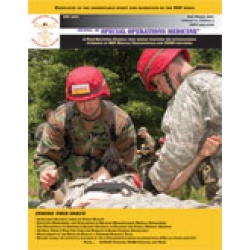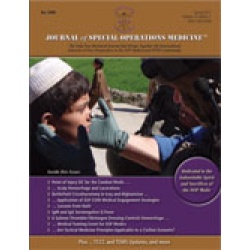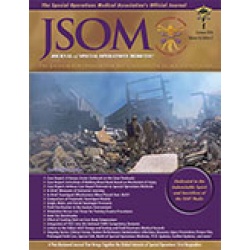Breakaway Media, LLC

Froede K 11(4). 21 - 24 (Journal Article)
Relevant literature demonstrates the absolute necessity of Special Operations Forces (SOF) clinical narratives to the medics they teach and care they deliver, and discusses the concept of narrative pedagogy via review of extant literature and also SOF-specific clinical literature. SOF clinicians (medics, physicians' assistants, physicians, etc.) provide advanced trauma, clinical, and preventive care in the most austere of combat environments. SOF clinicians have adopted specific paradigms for schooling, teaching, learning, and practice. An overarching theme within SOF-generated clinical literature is that of hermeneutics and the narrative pedagogy; SOF clinicians generate their evidence from experience and frequently tell stories to educate their peers, colleagues, and student medics to increase the knowledge of the entire community.
Tobin JM, Via DK, Carter T 11(4). 43 - 44 (Journal Article)
Asuku ME, Milner SM, Gerold KB 11(4). 28 - 30 (Journal Article)
Beadling C, Maza J, Nakano G, Mahmood M, Jawad S, Al-Ameri A, Zuerlein S, Anderson W 12(1). 10 - 16 (Journal Article)
This article presents findings from a survey conducted to examine the availability of foreign language and culture training to Civil Affairs health personnel and the relevance of that training to the tasks they perform. Civil Affairs forces recognize the value of cross-cultural communication competence because their missions involve a significant level of interaction with foreign governments' officials, military, and civilians. Members of the 95th Civil Affairs Brigade (Airborne) who had a health-related military occupational specialty code were invited to participate in the survey. More than 45% of those surveyed were foreign language qualified. Many also received predeployment language and culture training specific to the area of deployment. Significantly more respondents reported receiving cultural training and training on how to work effectively with interpreters than having received foreign language training. Respondents perceived interpreters as important assets and were generally satisfied with their performance. Findings from the survey highlight a need to identify standard requirements for predeployment language training that focuses on medical and health terminology and to determine the best delivery platform(s). Civil Affairs health personnel would benefit from additional cultural training that focuses on health and healthcare in the country or region of deployment. Investing in the development of distance learning capabilities as a platform for delivering health-specific language and culture training may help ease the time and resources constraints that limit the ability of Civil Affairs health personnel to access the training they need.
Hetzler MR 12(1). 1 - 10 (Journal Article)
Damage control principles are well founded, well proven, and have been incorporated into many specialties of clinical care in both military and civilian practice. Theories regarding hemostatic and hypovolemic resuscitation and preventing the Lethal Triad have had profound effects on the survival of wounded during the present conflicts. As we continue to refine these practices, implementation of this theory should be extended to military prehospital providers. The impacts of damage control practices from those providing initial treatment could complete the continuity of care, prime patients for additional success, and affect overall morbidity and mortality. The basic tenets of damage control theory are easily transferred to the Role I provider in the field and may even address their unique requirements more appropriately. Understanding the working concept of damage control would improve decision-making skills in both therapeutics and evacuation while managing casualties in the uncontrolled environment of combat. Military prehospital damage control differs greatly from in-hospital use, in that the principles must incorporate both medical and tactical considerations for care of the wounded. Introducing damage control principles to established casualty care guidelines will recognize and unite an often underappreciated level of care into a successful practice.
Mabry RL, Frankfurt A 12(1). 17 - 23 (Journal Article)
Objective: Historical review of modern military conflicts suggests that airway compromise accounts for 1-2% of total combat fatalities. This study examines the specific intervention of pre-hospital cricothyrotomy (PC) in the military setting using the largest studies of civilian medics performing PC as historical controls. The goal of this paper is to help define optimal airway management strategies, tools and techniques for use in the military pre-hospital setting. Methods: This retrospective chart review examined all patients presenting to combat support hospitals following prehospital cricothyrotomy during combat operations in Iraq and Afghanistan during a 22-month period. A PC was determined "successful" if it was documented as functional on arrival to the hospital. All PC complications that were documented in the patients' record were also noted in the review. Results: Two thirds of the patients died. The most common injuries were caused by explosions, followed by gunshot wounds (GSW) and blunt trauma. Eighty-two percent of the casualties had injures to face, neck or head. Those injured by gunshot wounds to the head or thorax all died. The largest group of survivors had gunshot wounds to the face and/or neck (38%) followed by explosion related injury to the face, neck and head (33%). Pre-hospital cricothyrotomy was documented as successful in 68% of the cases while 26% of the PC's failed to cannulate the trachea. In 6% of cases the patient was pronounced dead on arrival without documentation of PC function. The majority of PC's (62%) were performed by combat medics at the point of injury. Physicians and physician assistants (PA) were more successful performing PC than medics with a 15% versus a 33% failure rate. Complications were not significantly different than those found in civilian PC studies, including incorrect anatomic placement, excessive bleeding, air leak and right main stem placement. Conclusions: The majority of patients who underwent PC died (66%). The largest group of survivors had gunshot wounds to the face and/or neck (38%) followed by explosion related injury to the face, neck and head (33%). Military medics have a 33% failure rate when performing this procedure compared to 15% for physicians and physician assistants. Minor complications occurred in 21% of cases. The survival rate and complication rates are similar to previous civilian studies of medics performing PC. However the failure rate for military medics is three to five times higher than comparable civilian studies. Further study is required to define the optimal equipment, technique, and training required for combat medics to master this infrequently performed but lifesaving procedure.
Arne BC 12(1). 11 - 16 (Journal Article)
Scalp lacerations can vary in severity from a minor injury up to a complete degloving of the scalp. Severe scalp injuries can occur in a combat zone as a result of blunt trauma, penetrating trauma or blast-related mechanisms. More severe scalp wounds tend to cause a greater than expected blood loss and can contribute to patient destabilization relatively quickly. This article will discuss the source of blood supply to the scalp and concentrate on the management of scalp wounds with before and after pictures to demonstrate these techniques. The cases presented will exclude cranial fractures and concentrate more on the management of lacerations specifically
Menon AS, Norris RL, Racciopi J, Tilson H, Gardner J, Mcadoo G, Brown IP, Auerbach PS 12(1). 31 - 36 (Journal Article)
A team of emergency physicians and nurses from Stanford University responded to the devastating January 2010 earthquake in Haiti. Because of the extreme nature of the situation, combined with limited resources, the team provided not only acute medical and surgical care to critically injured and ill victims, but was required to uniquely expand its scope of practice. Using a narrative format and discussion, it is the purpose of this paper to highlight our experience in Haiti and use these to estimate some of the skills and capabilities that will be useful for physicians who respond to similar future disasters.
Irizarry DJ, Tate C, Bingham MT, Wey P, Batjom E, Nicholas TA, Boedecker BH 12(1). 24 - 30 (Journal Article)
The Medical Civic Assistance Program (MEDCAP) is a military commander's tool developed during the Vietnam War to gain access to and positively influence an indigenous population through the provision of direct medical care provided by military medical personnel, particularly in Counter Insurgency Operations (COIN). An alternative to MEDCAPs is the medical seminar (MEDSEM). The MEDSEM uses a Commander's military medical assets to share culturally appropriate medical information with a defined indigenous population in order to create a sustainable training resource for the local population's health system. At the heart of the MEDSEM is the "train the trainer" concept whereby medical information is passed to indigenous trainers who then pass that information to an indigenous population. The MEDSEM achieves the Commander's objectives of increasing access and influence with the population through a medical training venue rather than direct patient care. Previous MEDSEMS conducted in Afghanistan by military forces focused on improvement of rural healthcare through creation of Village Health Care Workers. This model can also be used to engage host nation (HN) medical personnel and improve medical treatment capabilities in population centers. The authors describe a modification of the MEDSEM, a Medical Mentorship (MM), conducted in November 2010 in Kabul, Afghanistan, at the Afghan National Army (ANA) National Medical Hospital. This training was designed to improve intubation skills in Afghan National Army Hospitals by ANA medical providers, leave residual training capability, and build relationships within the institution that not only assist the institution, but can also be leveraged to foster Commanders' objectives, such as health and reconstruction initiatives and medical partnering for indigenous corps and medical forces described below.
Floyd CT, Rothwell SW, Martin R, Risdahl J, Olson CE 12(1). 49 - 55 (Journal Article)
Battlefield hemorrhage remains the primary cause of death in potentially survivable combat injuries with noncompressible hemorrhage. Fibrin dressings have great potential for reducing mortality, however are limited by cost, availability, and disease transmission. Methods: Dressings comprising a soluble dextran dressing with lyophilized salmon thrombin and fibrinogen (STF) were tested against Combat Gauze (CG) as a control in a standard swine femoral artery hemorrhage model. Ten female swine were used in each arm of the study. Results: Survival, blood loss, and time to hemostasis were similar between the two dressings. Two of the CGtreated animals that survived exsanguinated during the simulated walking maneuver. Three CG-treated animals formed a clot within the wound, but the clot did not adhere to the femoral artery injury. All ten of the STFtreated animals formed a clot in the wound that adhered and sealed the arterial injury site, even in three animals that did not survive. None of the STF-treated animals bled following the simulated walking maneuver. Three of five STF-treated animals reestablished blood flow distal to the injury as demonstrated by angiography. Conclusions: The STF dressing is as efficacious as CG in treating hemorrhage in this model of a lethal injury. Further, the STF dressing formed a fibrin sealant over the injury, whereas CG achieved hemostasis by occlusive compression of the artery. The sealant property of the STF dressing allowed reestablishment of antegrade blood flow into the distal limb, demonstrating that this dressing has the potential of limb salvage in addition to control of life-threatening hemorrhage.
Chagaris MJ, Smith RC, Goldstein AL 12(1). 37 - 48 (Journal Article)
We present Q fever as a credible hypothesis for Gulf War Veterans' Illnesses (GWVIs) and as a possible etiology for prevalent symptomologies affecting currently serving servicemembers. Q fever is caused by the bacteria Coxiella burnetii, which is endemic throughout the Middle East. Q fever may manifest in many forms of widely varying and often inconstant symptoms. Due to false-negative interpretations in current and past diagnostic testing, Q fever has not received appropriate consideration as a possible causative agent for medically unexplained veterans' illnesses. Review of current literature invites us to consider that a form of Q fever involving an incomplete immune response is a potential cause of these debilitating illnesses. We hypothesize C. burnetii infection coincidental to exposures suppressing antibody-specific immune response results in infection mediated by immunoglobulin D (IgD). Literature indicates that successful treatment for this form of Q fever requires the concurrent administration of doxycycline and hydroxychloroquine.
Hellums JS 12(1). 56 - 61 (Journal Article)
Special Forces Medical Sergeants (SFMS) are independent multidisciplinary medical personnel who possess unique medical skill sets that require regular practice in order to maintain proficiency. Due to high operational tempo, the windows of opportunity to practice these abilities are usually limited to short periods of required training to maintain credentials. A Special Forces (SF) Battalion allowed their medical section to orchestrate a weeklong medical training event that included emergency procedure lectures, human cadaver training, ultrasound familiarization, medical administration instruction, and behavioral health discussions. This training enabled the SFMS to hone their competencies and increase their clinical confidence while working and learning from each other and other medical providers. The training event was a great success.
Orr R, Knapik JJ, Pope R 16(2). 91 - 95 (Journal Article)
This article defines the concept of program-induced cumulative overload (PICO), provides examples, and advises ways to mitigate the adverse effects. PICO is the excessive cumulative physical workload that can be imparted to military personnel by a military training program with an embedded physical training component. PICO can be acute (accumulating within a single day) or chronic (accumulating across the entirety of the program) and results in adverse outcomes for affected personnel, including detrimental fatigue, performance degradation, injuries, or illness. Strategies to mitigate PICO include focusing administration and logistic practices during the development and ongoing management of a trainee program and implementing known musculoskeletal injury prevention strategies. More training is not always better, and trainers need to consider the total amount of physical activity that military personnel experience across both operational training and physical training if PICO is to be mitigated.
Winn AE, Rivard SC, Green B 16(2). 96 - 100 (Journal Article)
Tattoos are ubiquitous in modern society; however, they do not come without risk of medical complications. When complications arise in the military community, a particularly thorough differential diagnosis should be considered based on the increased exposures service members have during deployment and throughout their military career. We present a case of a 38-year-old active duty US Marine Corps woman with worsening skin lesions arising within a tattoo 6 weeks after acquiring the tattoo on her right chest. Given environmental exposures from a recent deployment to the Middle East, a wide differential was considered. Ultimately, a skin biopsy revealed early hypertrophic scar formation responsive to therapy with intralesional triamcinolone acetonide (Kenalog® [ILK]). However, given the Marine had recently deployed and is part of the active duty population, consideration of alternative, albeit rare, etiologies was imperative.
Helmus S, Blythe J, Guevara P, Washington MA 16(2). 101 - 104 (Journal Article)
Waterborne infection is an important cause of morbidity and mortality throughout the world. Personal hydration packs have been used by military personnel since the Gulf War and are now a common issue item. Since military personnel tend to operate under austere conditions and may use a variety of water sources, preventing the acquisition of waterborne infections is extremely important. Further, since hydration pack water reservoir replacements may not be available during combat operations, the development of a reliable cleaning protocol for use in the field is essential. Several methods for cleaning have been described. In the current study, three common cleaning methodologies-bleach treatment, baking soda treatment, and proprietary CAMELBAK Cleaning Tabs™-were evaluated for the ability to remove Escherichia coli contamination from hydration pack water reservoirs. The study results suggest that the use of bleach and proprietary CAMELBAK tablets should be encouraged since they both operate by releasing bactericidal chlorine compounds into solution, which is more effective at reducing post-treatment bacterial burden. It should be noted that no method was 100% effective at completely eliminating bacteria from the reservoirs and that mechanical cleaning was not attempted.
Buckenmaier CC, Galloway KT, Polomano RC, Deuster PA 16(2). 82 - 87 (Journal Article)
The intense physical demands and dangerous operational environments common to Special Operations Forces (SOF) result in a variety of painful conditions, including musculoskeletal pain, headaches, and acute and chronic pain from combat injuries. Pain is a wellaccepted barrier to human performance. The Pain Management Task Force and the development of the Defense Veterans Pain Rating Scale (DVPRS) are discussed to provide a framework for changing the culture of pain management away from intensity of pain to interference with function and performance. The emergence of complementary and integrative pain management (CIM) practices is briefly reviewed as viable alternatives to the traditional reliance on opioids and other prescription medications. The SOF community can be the change agent for the DVPRS and CIM approaches to pain management, which will in the end serve to accelerate recovery and return SOF operators to duty faster and with an enhanced ability to perform with less pain.
Banting J, Meriano T 16(2). 78 - 81 (Journal Article)
The series objective is to review various clinical conditions/ presentations, including the latest evidence on management, and to dispel common myths. In the process, core knowledge and management principles are enhanced. A clinical case will be presented. Cases will be drawn from real life but phrased in a context that is applicable to the Special Operations Forces (SOF) or tactical emergency medical support (TEMS) environment. Details will be presented in such a way that the reader can follow along and identify how they would manage the case clinically depending on their experience and environment situation. Commentary will be provided by currently serving military medical technicians. The medics and author will draw on their SOF experience to communicate relevant clinical concepts pertinent to different operational environments including SOF and TEMS. Commentary and input from active special op


 English
English 


